Introduction
There are many wonders of modern architecture that maze with the stylistic and structural decisions implemented in them. Nowadays, to help erect those buildings, people typically resort to using current technology. However, those innovations did not exist when Egyptians assembled their pyramids and other wonders of construction. Despite that, many individuals, both with and without a background in architecture, still find many of the cultural monuments in the African country to rival or even exceed modern ones. The amazement from seeing the actual pyramids is grand to the point that some people have resorted to using the existence of these structural feats as proof of alien life. Otherwise, these individuals find it difficult to imagine how such monuments could be constructed without the use of modern technologies. Additionally, the impact that these constructions have on people influences many current projects that in one way or another borrow from this ancient culture. The purpose of this paper is to analyze some manifestations of and techniques used in Egyptian architecture and how they are incorporated nowadays.
Egyptian Pyramids
Background Information on the Egyptian Pyramids
One of the most recognized symbols of Egyptian architecture is the pyramids. Currently, there are over a hundred of them that have been discovered all over the country with two of them being particularly famous. Firstly, the pyramid of Djoser is highlighted not only due to its intricate architecture consisting of steps but also due to the fact that it is the oldest stone structure in the world (Picture 1). Secondly, the pyramid of Khufu, also known as the Great Pyramid of Giza, is so impressive in its size that it is considered one of the Seven Wonders of the world (Picture 2). While similar structures are present in other cultures, including the Mesopotomaymian and the Mayan ones, they are without a doubt most closely associated with Egypt. Additionally, while the etymology of the word “pyramid” is beyond its presence in Greek and Latin, there are theories that tie it to the Egyptian phrase of “height of construction”.
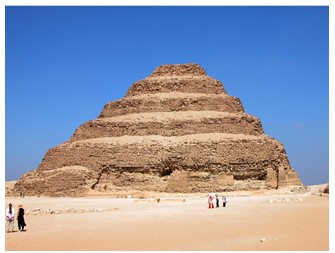
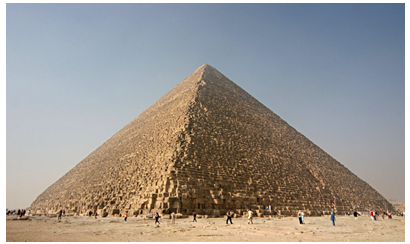
The Construction of Egyptian Pyramids
Pyramids are constructions that take the form of the eponymous geometrical form, the sides of which appear to be triangles that connect at a single point at the top. For many years now, architects and historians alike are baffled by the methods and techniques that went into building these monuments without the use of modern technologies. The two biggest questions focus on how the stones were cut into blocks and how they were moved up the sides of the constructions. However, there are several theories based on the evidence from the pyramids that exist to this day that aim to explain the Egyptian building process.
One of the leading theories behind the workers being able to move the blocks up the sides of the pyramids is that they used ramps. A contraption of this sort was discovered in Hatnub, a quarry region in Egypt (Picture 3). Additionally, historians believe that this system already existed during the construction of the Great Pyramid of Giza (Little). Other excavation sites have evidence of ruins that might have been ramping as well. These contraptions could in theory be straight or in the shapes of a zigzag or a spiral. Another theory for the way the top of the pyramid was constructed includes the possible use of levers to achieve their impressive heights. The proposal of such a system is based on the fact that many of the Egyptian monuments are adorned by projecting bosses, wedges, and sockets which could have helped with moving large blocks (Hussey-Pailos 27). It is worth noting that both theories could be true as Egyptians could have used different techniques and methods to build the pyramids.
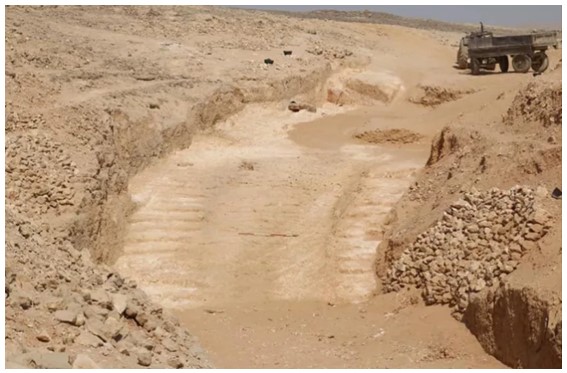
The way the workers cut blocks out of stone without the help of modern technology is a difficult question as well. The most widespread theory proposes the use of wedges that were inserted into holes in the granite and soaked in water which made them expand and break the material into different parts (McKenzie). Additionally, historians propose that the blocks were not cut out of stone but instead cast out of limestone. This explanation is further supported by the fact that the modern word “adobe” which describes a mudbrick can be traced to Middle Egyptian.
The Influence of Egyptian Pyramids in Modern Architecture
People do not know the exact methods that the Egyptians implemented in their monuments. However, the theories outlined in the previous section are popular not only due to the evidence found on the sites of the pyramids but, additionally, because these techniques were used later on in other civilizations. Considering how influential the Egyptian culture was, it is fair to assume that the chosen methods of erecting the impressive monuments were later adopted by other countries.
The form of the pyramids themselves continues to be implemented in modern architecture to this day. It is particularly impressive that many types of buildings take the shape of this geometric figure. Nowadays, there are arenas, palaces, city centers, monuments, and many other constructions that outwardly look like pyramids. The most famous example would be the Louvre Museum in Paris that is a widely-recognized French symbol (Picture 4). Additionally, it is worth noting that citizens and tourists alike still enjoy visiting the ancient monuments in Egypt despite there being many constructions in the shape of this geometric form in modern architecture.
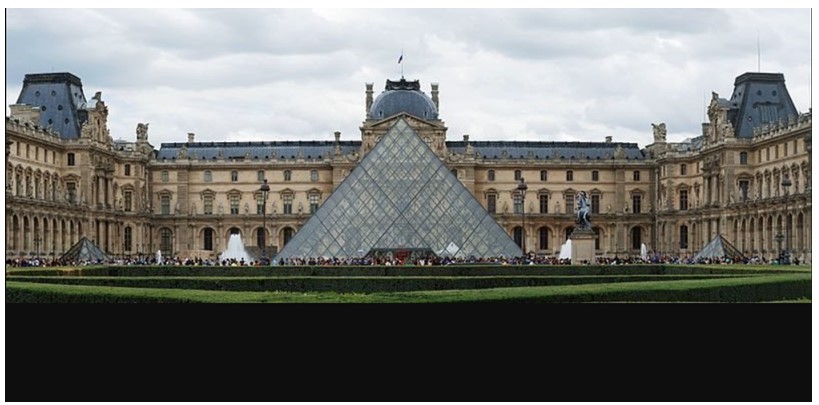
Egyptian Columns and Capitals
Another important element of Egyptian architecture are the columns and capitals that play an important part in adorning many different types of structures. When one mentions these features, most people would typically imagine them to look as they did in the cultures of Ancient Rome and Greece. However, Egyptian architects and painters had a different approach when adding columns to monumental complexes (Picture 5). This is particularly noticeable with the intricate designs and vibrant colors that are present on Egyptian capitals (Picture 6). While there are theories that Roman and Greek monuments used to have paint on them that fades or chipped away over time, it is still apparent that Egyptian architects favored intense hues and intricate designs more than their counterparts. Additionally, the used method of applying paint to the surface might have helped preserve the color over time. Prior to adding any pigments, Egyptian painters would cover the walls in plaster. It is interesting to note that in this culture, the color scheme was vital to the painting’s meaning as each hue had its own significance.
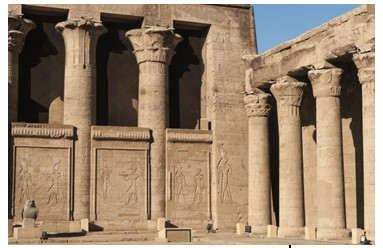
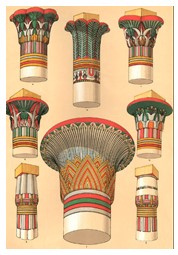
The designs that adorn the capitals of Egyptian columns are believed to have influenced the art deco style that was popular during the early 20th century. In particular, the artists of the time adopted the vibrant colors and the geometric patterns that appear frequently on the columns and walls of ancient monuments (Picture 7). The appeal of the designs themselves was a big reason for the inspiration. However, the fact that Egyptian culture often represented luxury and regality was important as well, as people were trying to incorporate such themes into art after World War I.
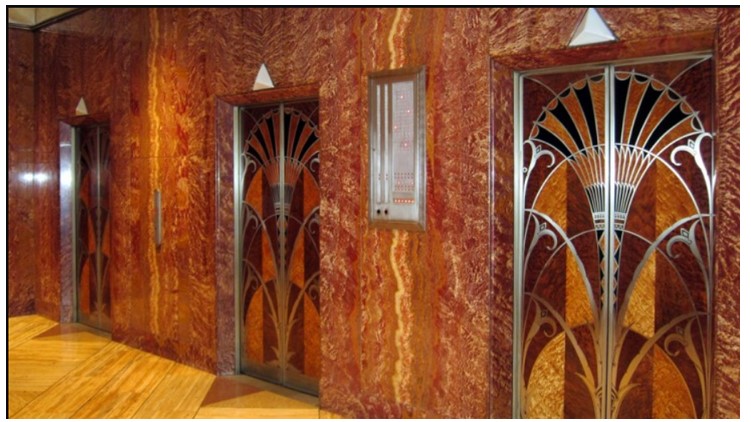
Conclusion
Egyptian culture is familiar to all people living nowadays from its mythology to its government and from its hieroglyphs to its art and architecture. However, one of its biggest symbols is the pyramids that still attract many tourists and baffle most historians. Due to their impressive size, recognizable design, and purpose of being a burial ground they are considered one of the most notable wonders of architecture. This reaction is further fueled by the fact that professionals still cannot agree on a singular explanation of how the pyramids were built. Nevertheless, these monuments have managed to influence both the techniques of erecting such structures and the designs implemented in them with many modern buildings having this geometric shape. Additionally, many other elements of Egyptian architecture are found impressive by the current community, particularly the capitals that adorned columns and served as inspiration for the art deco movement. Overall, despite the culture of this civilization being ancient, it continues to influence many areas of modern life.
Works Cited
Hussey-Pailos, Robert Scott. Construction of the Top of the Egyptian Pyramids: An Experimental Test Of A Levering Device. 2005. The University of Florida. MA Thesis.
Little, Becky. “How Did Egyptians Build the Pyramids? Ancient Ramp Find Deepens Mystery.” History, 2020.
McKenzie, Eleanor. “How Was Granite Quarried in Ancient Egypt?” Sciencing, 2017.